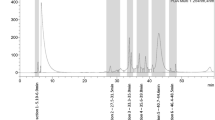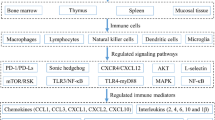Abstract
A new compound, rotenoid isoflavone glycoside named, 6′-O-β-d-glucopyranosyl-12a-hydroxydalpanol was isolated from the methanolic (MeOH) fruit extract of Amorpha fruticosa LINNE by means of multi-stage column chromatography. Immuno-modulatory activities of this new glycoside were compared with the partitioned fractions of Amorpha fruticosa LINNE. Both of the fractions and purified single compound showed a 19% relatively low cytotoxicity at a maximum concentration of 1.0 g/L in a cultivated normal human lung cell line (HEL299). The purified single compound showed less cytotoxicity than the crude extracts, possibly because residual toxicants were eliminated during purification processes. Cell growth of human T cells was increased by about 15% by adding 0.5 g/L of the fractions compared to the control. Specific production rates of interleukin-6 (IL-6) and tumor necrosis factor (TNF-α) from T cell were higher as 1.16 × 10−4 and 1.86 × 10−4 pg/cell, respectively, in the purified compound, compared to 1.38 × 10−4 and 2.22 × 10−4 pg/cell, respectively, by adding 0.5 g/L of the dichloromethane fraction. Natural killer cell-92MI (NK-92MI) growth supplemented with the supernatant of human T cell was up to 19% higher with the dichloromethane fraction compared with a new single compound at a concentration of 0.5 g/L. Overall, the dichloromethane fraction showed relatively higher immuno-modulatory activities compared with a new single compound, probably due to the synergic effect given by other substances existing in the fractions.







Similar content being viewed by others
Abbreviations
- NK cell:
-
Natural killer cell
References
Claisse J, Crombie L, Peace R (1964) J Chem Soc 6023
Crombie L, Peace R (1963) Proc Chem Soc 246
Doll R, Peto R (1981) The causes of cancer, quantitative estimates of avoidable risks of cancer in the United States today. J Natl Cancer Inst 66:1192
Han BH, Park MH, Cho JY, Park JS, Yoo ES, Baik KU (1998) Effect of insenosides from Panax ginseng on TNF-α production and T cell proliferation. Yakhak Heoji 42:296–301
Huh MK, Huh HW (1997) Allozyme variation and genetic structure of Amorpha fructicosa L. population in Korea. Korean J Genet 19:39–47
Kemal M, Wahba Khalil SK, Rao NG, Woolsey NF (1979) Isolation and identification of a cannabinoid-like compound from amorpha species. J Nat Prod 42:463–468
Lee MK, Lee HS, Choi GP, Oh DH, Kim JD, Yu CY, Lee HY (2003) Screening of biological activities of the extracts from Rubus coreanus Miq. Korean J Med Crop Sci 11:5–12
Lee HJ, Lee HJ, Kwon YH, Choi DH, Paik KH (2003) Extracts from fruits of Amorpha fruticosa (I). Mokchae Konghak 31:8–14
Lee SH, Lee HS, Park YS, Hwang B, Kim JH, Lee HY (2002) Screening of immune activities in the leaves of Dendropanax morbifera Lev. Korean J Med Crop Sci 10:109–115
Lee Y, Shin HS (1977) A study on the lipid components of Amorpha fruticosa seed. Korean J Foods Sci Technol 9:254–290
Li L, Wang HK, Chang JJ, McPhil AT, McPhil DR, Terada H, Konoshima T, Kokumai M, Kozuka M, Estes JR, Lee KH (1993) Antitumor agents, 138. rotenoids and isoflavones as cytotoxic constitutents from Amorpha fruticosa. J Nat Prod 56:690–698
Limdbolum CK (2002) IL-2 receptor signaling through the Shb adapter protein in T and NK cells. Biochem Biophy Res Commun 296:929–936
Reisch J, Gombos M, Szendrei K, Novak I (1976) 6a,12a-dehydro-α-toxicarol, ein neues potenoid aus Amorpha fruticosa. Phytochemistry 15:234–235
Norman DO, Smith HA (1981) Applied regression analysis. 2nd edn. Wiley and Sons, pp 345–348
Ohyama M, Tanaka T, Iinuma M (1998) A prenylated flavanone from roots of Amorpha fruticosa. Phytochemistry 48:907–909
Rozsa Z, Hohmann J, Reisch J, Mester I, Szendrei K (1982) Amorinin, a prenylated chromenoflanavanone from Amorpha fruticosa. Phytochemistry 21:1827–1828
Rozsa Z, Hohmann J, Szendrei K, Mester I, Reisch J (1984) Amoradin, amoradicin and amoradinin, three prenylflavanones from Amorpha fruticosa. Phytochemistry 23:1818–1819
Shibata H, Shimizu S (1978) Hetrocycles 10:85
Toomey JA, Gays F, Foster D, Brooks CG (2003) Cytokine requirements for the growth and development of mouse NK cells in vitro. J Leukoc Biol 74(2):233–242
Yueran Z, Rui S, You L, Chunyi G, Zhigang T (2003) Expression of leptin receptors and response to leptin stimulation of human natural killer cell lines. Biochem Biophy Res Commun 300:247–252
Wang BH, Lee SY (1974) Studies on the fatty acid composition of Amorpha fruticosa seeds. Korean J Foods Sci Technol 6:86–90
Acknowledgements
Special thanks to Mr. Albert Lee who devotedly assisted with technical support. This work was (in part) supported by the Ministry of Commerce, Industry and Energy through the Center for Efficacy Assessment and Development of Functional Foods and Drugs at Hallym University, Korea.
Author information
Authors and Affiliations
Corresponding author
Rights and permissions
About this article
Cite this article
Lee, H.J., Kang, H.Y., Kim, C.H. et al. Effect of new rotenoid glycoside from the fruits of Amorpha fruticosa LINNE on the growth of human immune cells. Cytotechnology 52, 219–226 (2006). https://doi.org/10.1007/s10616-006-9040-5
Received:
Accepted:
Published:
Issue Date:
DOI: https://doi.org/10.1007/s10616-006-9040-5




